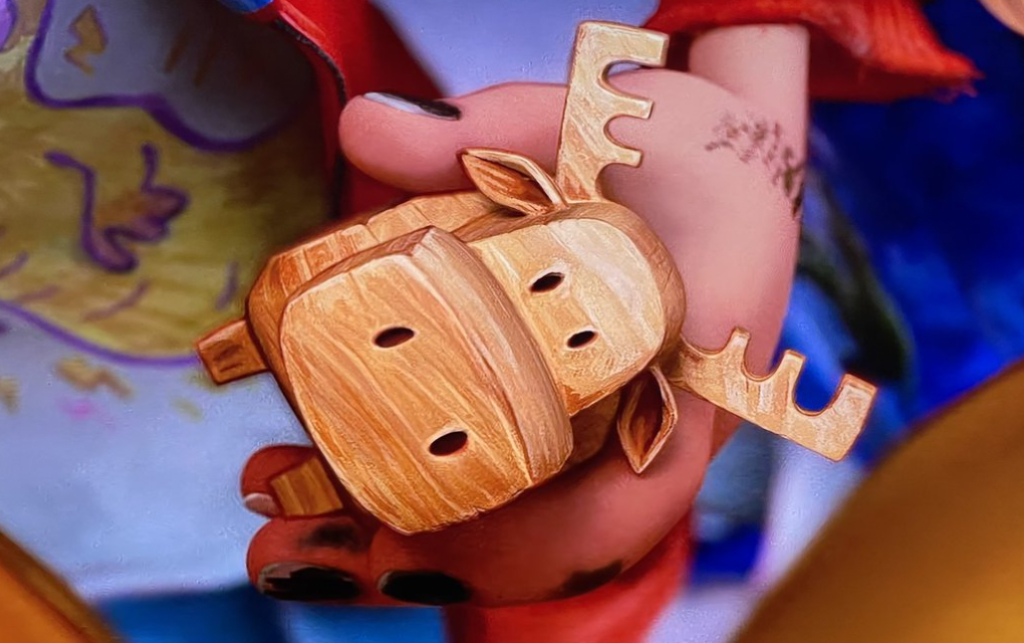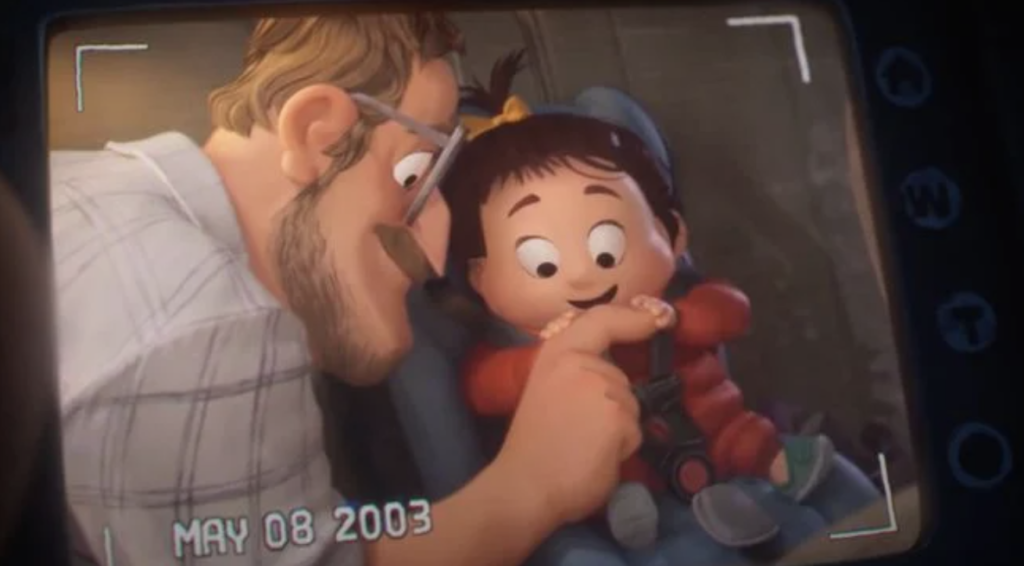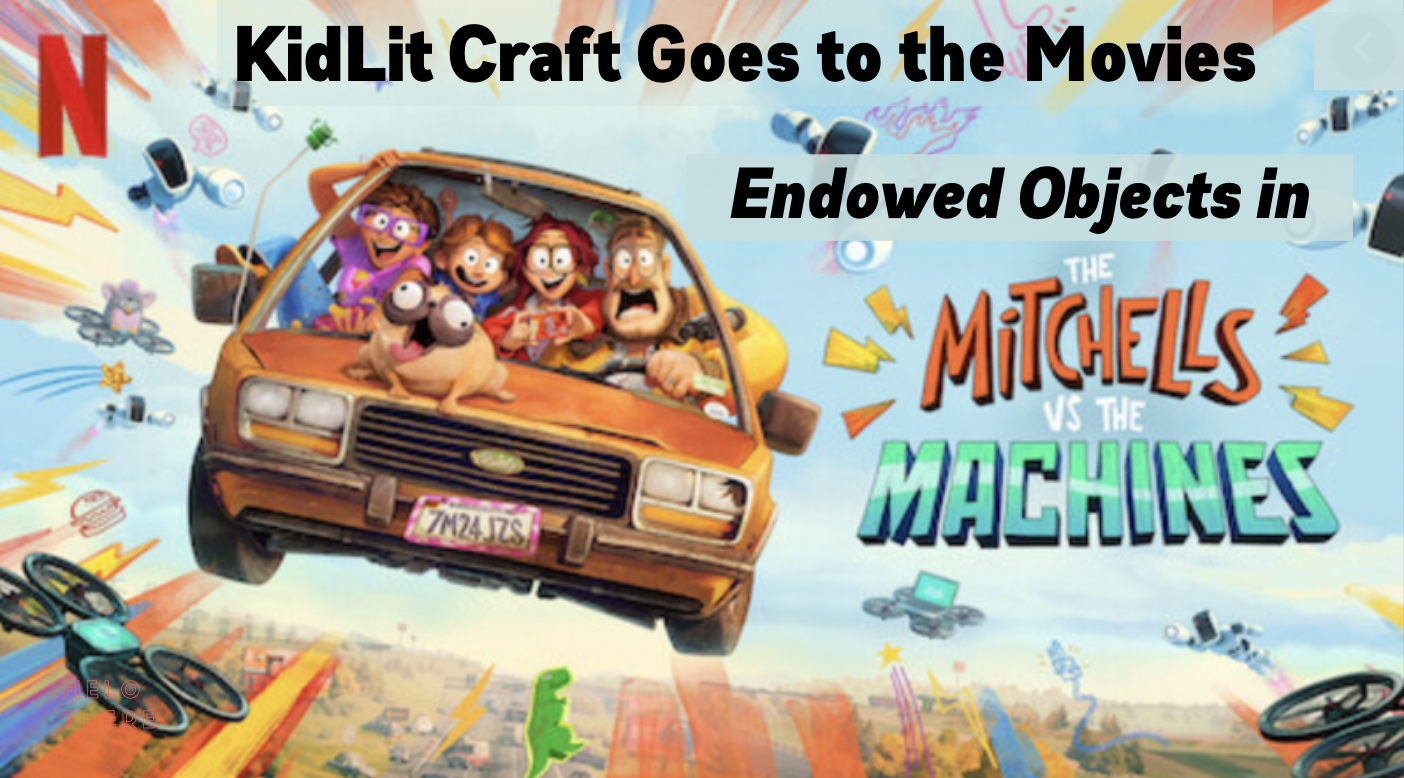An occasional series where we examine craft elements in film that transfer to fiction (and non-fiction).
craft review by Anne-Marie Strohman
Stories are all about emotion, but labeling emotions often feels too on the nose (“Rani was sad”), and making characters physically express emotion (tears, eye rolling, crossing their arms) often feels cliche. So how can you get emotion on the page?
Step one is to focus your attention on the right emotion–the reader’s emotion. Your goal is to make your readers feel things. Sometimes what the character is feeling, and sometimes a different reaction.
One way to get an empathetic emotional reaction from your reader is using an endowed object. An endowed object is an object in the story that accrues meaning through a scene or two, and then signals an emotion when introduced later. It sounds formal and complicated but it’s pretty straightforward in practice. You may already be using endowed objects in your work without realizing it!
The Mitchells vs. the Machines
A new film out on Netflix from Sony Pictures Animation, The Mitchells vs. the Machines uses one striking endowed object to add just the right amount of heart into the action-comedy mix: a small wooden moose.

In the movie, quirky teen artist Katie Mitchell is getting ready to leave for college. She is ready to find her people, and she has already connected with some fellow classmates online. Her dad doesn’t get her at all, and she’s so ready to move out. Dad wishes they had time to restore their relationship, so he cancels Katie’s plane ticket and decides they will take a family road trip to drop Katie off at college. And then the robot apocalypse happens. Literally. (You can find the trailer here.)
The endowed object signals the emotional core of the movie–the relationship between Katie and her dad.
The Moose is Introduced
The moose first shows up twelve minutes into the movie. Katie has just stomped off into her room, and Dad is in the hallway. He peeks into a box marked “Give Away” and finds the small carved moose. His face is sad. He finds an old video camera nearby and plays back some old tapes. We watch with him.
The Moose is Endowed with Meaning
The clip looks like it’s from Katie’s first day of school. She’s a small child, there’s a bus in the background, and Dad is encouraging her to go to the bus while Mom films. We can see the moose on the dashboard in the first image.
Then we watch as the moose takes center stage.
Katie: Don’t make me go!
[Dad goes to the car and takes the moose off the dashboard]
Dad: Take this.
Katie: This is like your favorite thing.
Dad: It’s yours now. See, this little guy is scared to be alone, so you’re going to have to cheer him up for me, okay? Do you know how to say “I love you” in moose language?
[Dad bellows like a moose. Katie laughs.]
In this scene, the moose is endowed with meaning–it is Dad’s “favorite thing,” he willingly gives it to Katie to comfort her, and it’s a bridge to making her laugh. It’s an object that bonds them.
This information helps viewers make sense of Dad’s sadness–Katie has put the moose in the “Give Away” box, and we can deduce that Dad feels like Katie has given up on their relationship. The moose has become a symbol of their relationship.
After the video clip, we see Dad in the dark room holding the moose. He stands and says, “All right. Let’s fix this.” Dad’s definition of fixing things is the inciting incident–the Mitchells are going on a road trip together.
The Moose Returns
The next time we see the moose is just over an hour and five minutes into the film. Katie opens a photo book, and the first photo is an image of a log cabin with a carved moose sitting on the newel post at the bottom of the steps. Mom tells Katie that Dad built that cabin.
It’s a quick aside, but it brings the moose back into focus and reminds us of the connection between the moose and Dad, and the meaning the object is endowed with.
Three minutes later, as the family is executing Katie’s plan to dress up as robots to get close to the evil robot leader (a Siri-like app named PAL), Dad takes the moose from his pocket and tucks it in Katie’s backpack. The backpack stays in the car.
This logistical move is important later, but it also shows us that Dad wants Katie to feel supported as they’re going off to do something scary. But their relationship is still not at the point where he could give it to her in person.
The Moose is Endowed with MORE Meaning
Just five minutes further into the movie, the moose returns, in a way that endows it with more meaning. Katie and her little brother have just escaped from some robots and are regrouping. Katie grabs her backpack out of the car. She finds the moose in her backpack. (1:13:25-1:14:15). This is a throwaway moment–we find out that Katie knows where the moose is.
Then, Katie and her brother watch old footage they find on the tape that’s in the video recorder Katie’s been using on the trip. It’s of the day Mom and Dad and baby Katie move away from the log cabin.

[Dad is looking sadly at the cabin.]
Mom: “I know this is hard for you.”
[Dad comes over to the car, ducks into the backseat and lets Katie grab his finger.]
Dad: “Nah–it’s easy.”
[Dad walks over to the porch and takes the moose off the newel post.]
Dad: “Something to remember the place by.”
So now the moose isn’t just a symbol of Dad and Katie’s relationship from the first day of school, it’s a symbol for what Dad gave up to make a life for their family.
Katie then holds the moose. She turns to her brother and says, “I’m going to make it up to all of you.”
This scene mirrors the Dad/moose scene at the 12-minute mark. Through a combination of the object and an old movie (flashback), the character holding the moose is resolved to take action. Dad at the inciting incident, and Katie moving into the climax.
The Final Moose Moment
The endowed object appears once more in the movie, at 1 hour and 37 minutes in. It is a culmination of all the emotions and relationship moments that have happened with the moose. It mirrors an earlier scene. All of these layers create a satisfying emotion. I’ll let you watch it to see how it plays out.
Endowed Objects are Magic
The moose is meaningful to both Dad and Katie, and the movie creates additional layers of meaning through the old movies (flashbacks) and the way the moose moves from person to person. We know what the moose means, so we can imagine what the characters are feeling, and ultimately, we feel it too.
Endowed objects are a powerful way to amplify emotion so that readers can know what characters are feeling and feel things themselves.
Try adding an endowed object to your work-in-progress and see what happens!
Now it’s YOUR Turn!
Start with sidewriting:
- Write a scene where one character gives another a gift.
- Write a scene where that gift is taken away, lost, or thrown away.
- Write a scene where the gift is found or retrieved.
As you revise:
- When the endowed object is introduced, give it meaning right away.
- Use the object at least three or four times in the course of the story to signal character emotion and/or changes in relationships.
- Add additional meaning through flashback or story action.
- Use the object in a final scene that uses all the elements of emotion and relationship you’ve built in it through the story.
Want to dig deeper? Try this Sidewriting Challenge from David Macinnis Gill
Check out how Rajani LaRocca uses a POETIC REFRAIN to deepen emotional resonance
Or how Kate DiCamillo uses objects, description, and repetition to establish setting and to develop character and character relationships.
You can also SUBSCRIBE to our monthly newsletter. Near the end of each month, we introduce our featured author, highlight craft resources, and offer some writerly inspiration. We love writing it, and we hope you’ll love reading it!
Anne-Marie Strohman (co-editor) writes picture books, middle grade novels, and young adult short stories and novels. She is trained as a teacher, an editor, and a scholar, specializing in Renaissance Literature. She holds an MFA in Writing for Children and Young Adults from Vermont College of Fine Arts and is an active member of SCBWI. Find her at amstrohman.com and on Twitter @amstrwriter.

COMMENTs:
0